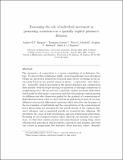Files in this item
Examining the role of individual movement in promoting coexistence in a spatially explicit prisoner's dilemma
Item metadata
| dc.contributor.author | Burgess, Andrew E. F. | |
| dc.contributor.author | Lorenzi, Tommaso | |
| dc.contributor.author | Schofield, Pietà G. | |
| dc.contributor.author | Hubbard, Stephen F. | |
| dc.contributor.author | Chaplain, Mark A. J. | |
| dc.date.accessioned | 2018-02-28T00:33:04Z | |
| dc.date.available | 2018-02-28T00:33:04Z | |
| dc.date.issued | 2017-04-21 | |
| dc.identifier | 249214691 | |
| dc.identifier | cd280183-308d-42ae-b1d9-2dcceec41c65 | |
| dc.identifier | 85014001202 | |
| dc.identifier | 000400033400031 | |
| dc.identifier.citation | Burgess , A E F , Lorenzi , T , Schofield , P G , Hubbard , S F & Chaplain , M A J 2017 , ' Examining the role of individual movement in promoting coexistence in a spatially explicit prisoner's dilemma ' , Journal of Theoretical Biology , vol. 419 , pp. 323-332 . https://doi.org/10.1016/j.jtbi.2017.02.028 | en |
| dc.identifier.issn | 0022-5193 | |
| dc.identifier.other | ORCID: /0000-0001-5727-2160/work/55378940 | |
| dc.identifier.uri | https://hdl.handle.net/10023/12813 | |
| dc.description | AEFB gratefully acknowledges the support of an EPSRC CASE PhD studentship. | en |
| dc.description.abstract | The emergence of cooperation is a major conundrum of evolutionary biology. To unravel this evolutionary riddle, several models have been developed within the theoretical framework of spatial game theory, focussing on the interactions between two general classes of player, "cooperators" and "defectors". Generally, explicit movement in the spatial domain is not considered in these models, with strategies moving via imitation or through colonisation of neighbouring sites. We present here a spatially explicit stochastic individual-based model in which pure cooperators and defectors undergo random motion via diffusion and also chemotaxis guided by the gradient of a semiochemical. Individual movement rules are derived from an underlying system of reaction-diffusion-taxis partial differential equations which describes the dynamics of the local number of individuals and the concentration of the semiochemical. Local interactions are governed by the payoff matrix of the classical prisoner's dilemma, and accumulated payoffs are translated into offspring. We investigate the cases of both synchronous and non-synchronous generations. Focussing on an ecological scenario where defectors are parasitic on cooperators, we find that random motion and semiochemical sensing bring about self-generated patterns in which resident cooperators and parasitic defectors can coexist in proportions that fluctuate about non-zero values. Remarkably, coexistence emerges as a genuine consequence of the natural tendency of cooperators to aggregate into clusters, without the need for them to find physical shelter or outrun the parasitic defectors. This provides further evidence that spatial clustering enhances the benefits of mutual cooperation and plays a crucial role in preserving cooperative behaviours. | |
| dc.format.extent | 10 | |
| dc.format.extent | 5642227 | |
| dc.language.iso | eng | |
| dc.relation.ispartof | Journal of Theoretical Biology | en |
| dc.subject | Spatial games | en |
| dc.subject | Random motion | en |
| dc.subject | Chemotaxis | en |
| dc.subject | Prisoner's dilemma | en |
| dc.subject | Spatial patterning | en |
| dc.subject | QA Mathematics | en |
| dc.subject | QH301 Biology | en |
| dc.subject | NDAS | en |
| dc.subject.lcc | QA | en |
| dc.subject.lcc | QH301 | en |
| dc.title | Examining the role of individual movement in promoting coexistence in a spatially explicit prisoner's dilemma | en |
| dc.type | Journal article | en |
| dc.contributor.institution | University of St Andrews. Applied Mathematics | en |
| dc.identifier.doi | https://doi.org/10.1016/j.jtbi.2017.02.028 | |
| dc.description.status | Peer reviewed | en |
| dc.date.embargoedUntil | 2018-02-27 |
This item appears in the following Collection(s)
Items in the St Andrews Research Repository are protected by copyright, with all rights reserved, unless otherwise indicated.

